Desperate times call for desperate measures. Determined to win back the world 500cc title in 1982, Yamaha put its star rider onto a completely untried V4. Here’s what happened
The 1982 season was a watershed moment in the 500cc Grand Prix world championship. It was the final year all four Japanese manufacturers including Yamaha went head-to-head in the championship, pushing the envelope with new or revised designs.
Yamaha was perhaps the most committed and, perhaps, also the one with the most to lose. Its star rider Kenny Roberts had rewritten the history books back in 1978 by becoming the first American to win the ultimate motorcycle title as well as delivering Yamaha its first world crown since Giacomo Agostini’s amazing effort in 1975. Proving he and Yamaha were no one-hit wonder, Roberts had repeated the effort in 1979 and 1980.
For 1981 Yamaha had introduced what some observers cynically describe as a copy of Suzuki’s RG500, the bike that Barry Sheene had taken to victory in 1976 and 1977. But it was surely no surprise that Yamaha would build a square-four replacement for its ageing piston-port, inline four-cylinder as the similar RG500 was the equivalent of the 1950s-60s Manx Norton. Although getting long in the tooth by racing standards, it filled most of the grid and even privateers were still winning rounds on it.
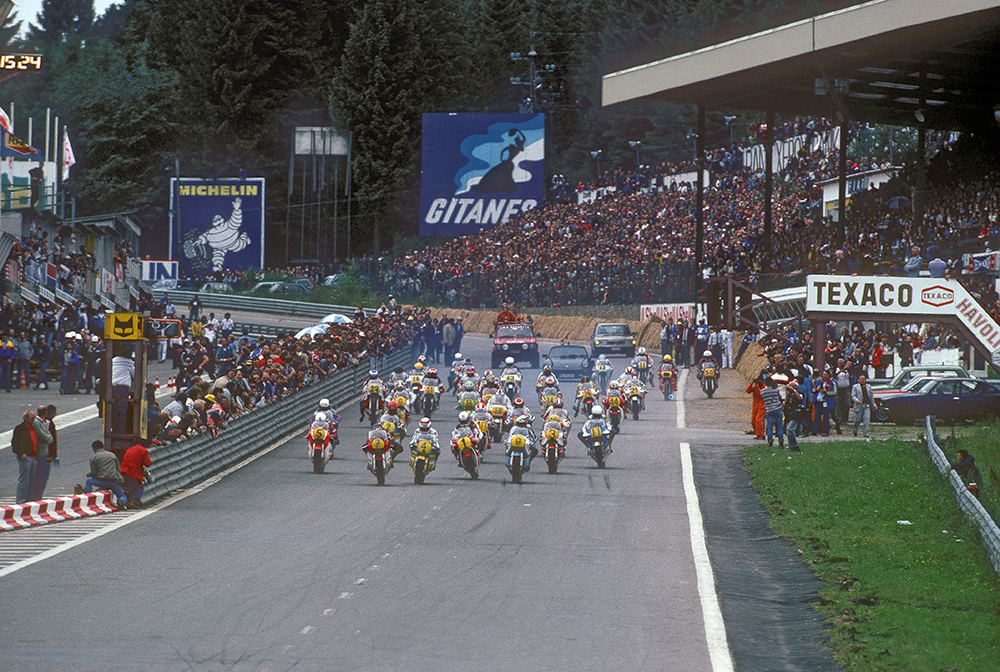
The start of the Belgian GP in 1982. Look at where the photographers are standing…
Despite the change of engine configuration, Yamaha’s rotary-valve, square-four 0W54 still lost out to Suzuki’s revised and lighter 1981 RG500, so the factory went all-out for season 1982. It was determined to make amends for Roberts’ disappointing third place in the points table behind Suzuki riders Randy Mamola and season champion Marco Lucchinelli.
Suzuki was defending its title with Franco Uncini, who had taken over from Lucchinelli, now riding for Honda. Yamaha’s Roberts and teammate Sheene (who had finished fourth and two points behind Roberts) were now on an uprated version of the 0W54, called the 0W60.
This was some 6kg lighter than the 0W54, which had matched the RG500 in performance but had a weak frame that had been continually modified by teams throughout the season. A completely new and much stronger chassis for 1982 saw the square-section alloy tubing reinforced with welded-in bottom frame rails and swingarm. A network of struts and plates added strength to the steering head area.
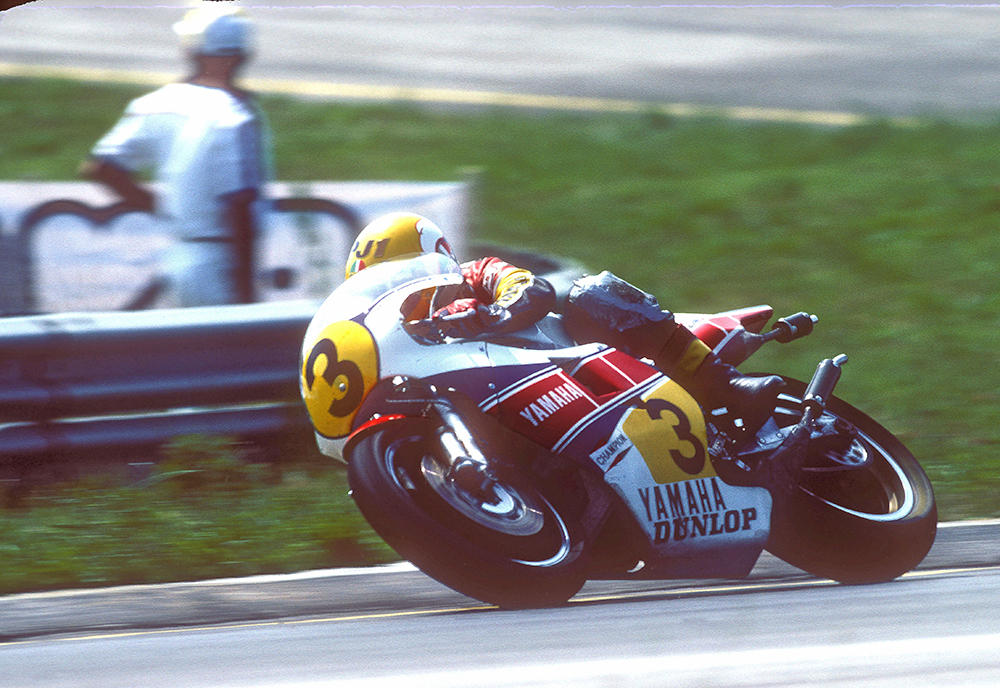
Roberts at work on the V4, on his way to fourth place at Spa
The most noticeable feature was the use of Yamaha’s ‘mono-cross’ suspension, which dated back to its revolutionary motocross racers of the early 1970s. The rear suspension unit was laid along the length of the main frame’s top rails operated via a bell crank arrangement, with adjustment by threaded rods.
The engine, which had its cylinders inclined at 45 degrees, ran through four separate crankshafts that counter-rotated in opposed pairs. YPVS power valves gave a broader spread of power while teflon-coated steel rotary discs and housings were aimed at improving reliability. Power output had been increased. Now 116kW (156bhp) arrived at 10,600rpm while a wet weight of well under 130kg ensured a top speed of over 300km/h.
Yamaha supplied eight of the 0W60s for season 1982. Two each went to Roberts, Sheene, Graeme Crosby (who had moved over from Suzuki) and Frenchman Marc Fontan (Sonauto Yamaha).
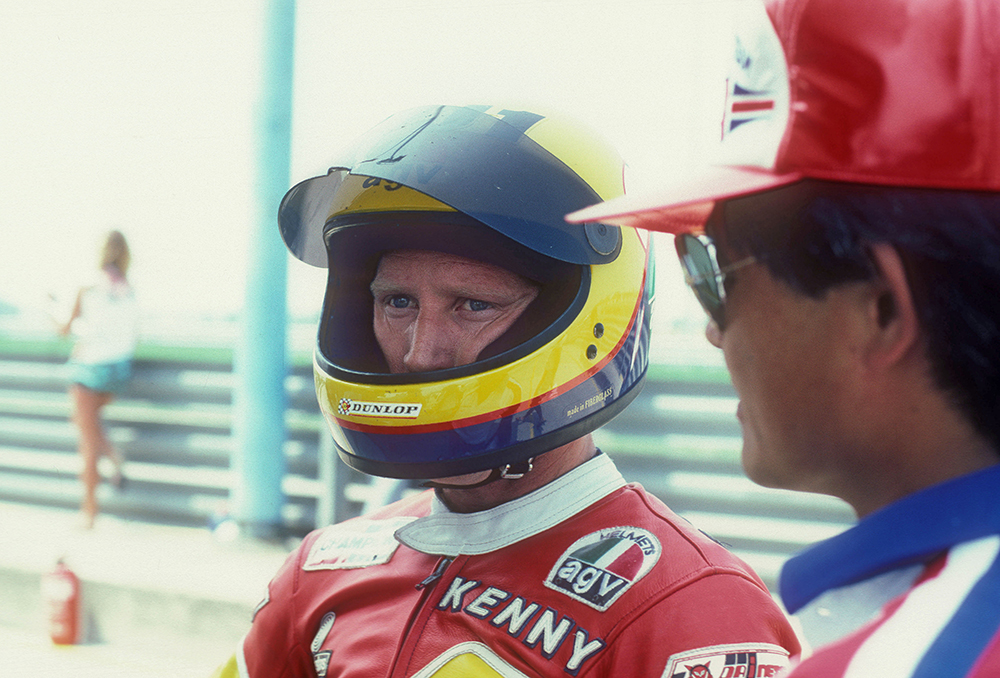
Kenny, with a Dunlop sticker on his helmet… it just doesn’t look right, does it?
Facing Yamaha was around 20 Suzuki RG500s. Honda, which had failed in its previous brave attempts with a four-stroke GP racer, had built a radical V3 two-stroke for 1982. It also had enlisted another American hotshot, youngster Freddie Spencer, to join Lucchinelli and veteran Takazumi Katayama.
Kawasaki soldiered on in its final season of 500cc racing with its KR500, changing from a monocoque to an aluminium backbone frame. So 1982 was shaping up to be a memorable season.
However, Yamaha had what it considered an ace up its sleeve. This was the world’s first two-stroke V4. Untried and unproven apart from the normal factory test riding regime, it was waiting in the wings. Roberts’ 0W60 failed in the pre-season Daytona 200, which Crosby won on a YZR750 0W31.
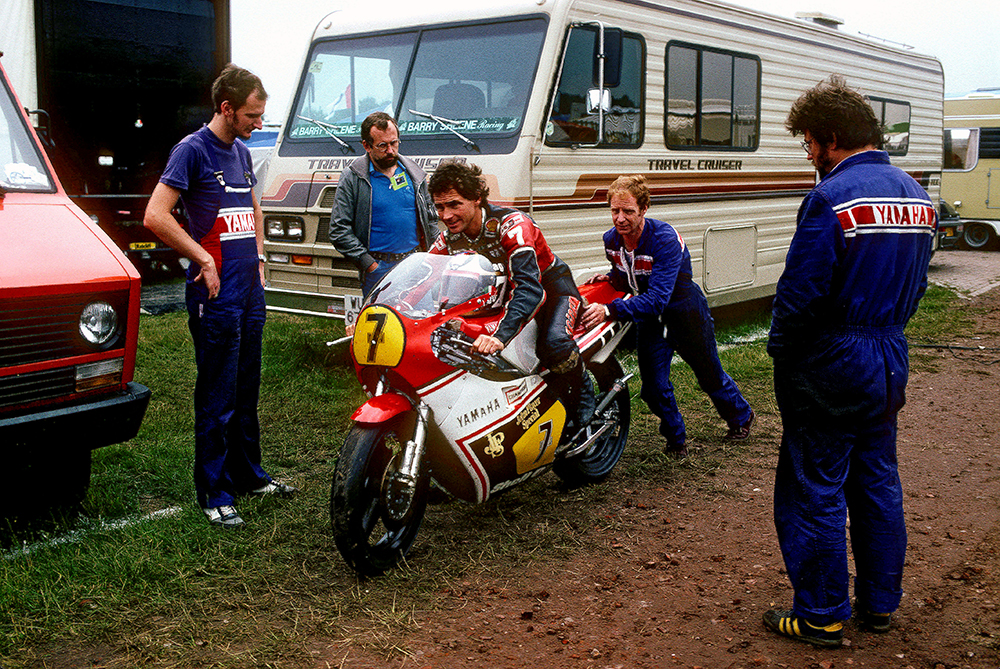
Barry Sheene gets a push in the paddock, which in 1982 looked like an actual paddock
Yamaha then started the 500cc world championship in the best possible way, with Roberts setting pole and winning the race in Argentina while fellow 0W60 riders Sheene finished second and Fontan seventh. It seemed to be an omen that Yamaha had finally got its rotary-valve square-four sorted.
Inexplicably, Roberts was then pulled off the 0W60 and put on the V4 0W61. Adding to the completely new experience was the fact that Roberts’ usual tyre supplier Goodyear had quit motorcycle racing and he was running Dunlops for the first time. Nevertheless, Roberts dug deep to finish third at the next round in Austria behind Sheene but ahead of Crosby.

Franco Uncini (10) leads Marc Fontan, Roberts, Sheene and Freddie Spencer
He actually won the Spanish round in a classic duel with Sheene, who was still on the square four, but podiums became harder and harder to achieve as the season wore on. This became a double whammy as the more development Yamaha poured into the V4, the more it ignored the square four 0W60.
Meanwhile Suzuki’s Uncini quietly went about collecting wins, podiums and championship points to secure the title with three rounds to spare. Crosby proved the continued worth of the square-four 0W60: no wins but a series of consistent podiums had him finishing second overall.

Sheene at Silverstone, before the practice crash that curtailed his career
In a portent of the future, Spencer nabbed third overall and along the way gave Honda its first 500cc win since 1967. Honda’s new star had adapted quickly to the V3 NS500. Sadly, despite his best efforts, Roberts finished another frustrating season fourth, but more importantly for Yamaha’s technical pride, ahead of teammate Sheene.
The Cockney hero, world GP’s first mainstream superstar, then publicly complained about not having had the chance to race the V4 all season. Both Crosby and Sheene had raced the 0W61 late in the season. Crosby rode it twice but preferred the 0W60 while Sheene’s first outing on the V4 came at the ill-fated British round at Silverstone. During free practice he rode into the unsighted wreckage of an earlier crash at 300km/h and was lucky to survive extensive injuries.
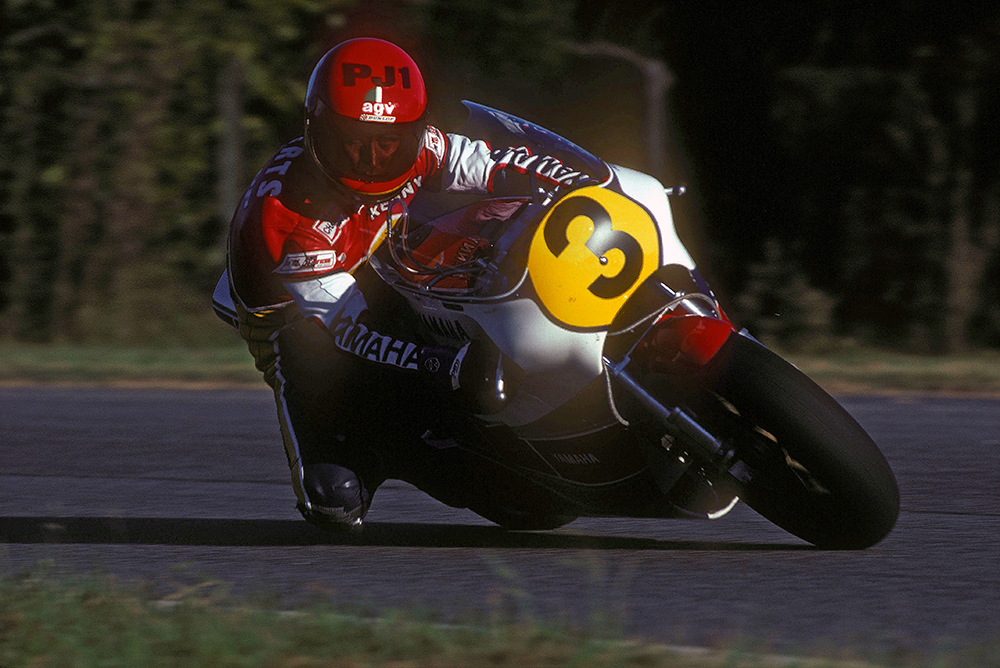
Roberts never really came to grips with the Yamaha V4
It had been an emotional season for all the Yamaha riders perhaps summed up by a disillusioned Crosby quitting GP racing, while Sheene was never the same championship contender after Silverstone. Even Roberts was hinting at impending retirement.
In a long interview with UK journalist Ted Macauley during the 1983 season, Roberts’ long-time mentor and crew chief Kel Carruthers gave an insight into the stress and strain of the previous two years.
“Kenny was angry a lot in 1981 and 1982 because he was having to try and compensate with guts and skill for machines that were just not up to the job,” he said. “The V4 was just wrong. It was out a year too early but we were stuck with it.
“The one before it, the square four, was simply too heavy. Kenny fell off one in Austria (0W54 in 1981) and it broke in half. I spent all my time doing modifications. I was up to my knees in shavings in the tent working on Barry Sheene’s and Kenny’s bikes.
“It was hard work. I used to machine the cylinders, heads and regrind the ports. I was nearly dizzy with all the effort.”

Carruthers and Roberts, 1982 500GP
This period of GP 500cc racing also saw increased power putting a whole new focus on the role of racing slicks.
“On top of it all, we had the added problem of difficulties with the tyres,” Carruthers told Macauley. “That suddenly jumped into being a whole new technology on its own. And by the time you had fiddled around with them, changing them, trying to work out what compound to use, there was less time to spend on the engine or suspension.”

Spa is still the fastest-ever GP track, at an average race speed of over 215km/h. This is the famous Eau Rouge
The 1980s, where technicians had free rein over a complete factory GP motorcycle and all its workings, meant a vortex of changes between practice and qualifying sessions. There was always a risk of something potentially deadly being overlooked, such as brake pads incorrectly fitted or a gearbox with false neutrals. Pre-race stress was a strange form of adrenalin that affected everyone in pit lane. Some rose above it all. Some didn’t.
“It’s a tremendous testimony to Kenny’s total professionalism that he did as well as he did (in 1981-82) considering the overwhelming difficulties he was facing,” Carruthers told Macauley. “But then nobody could ever question his dedication.”
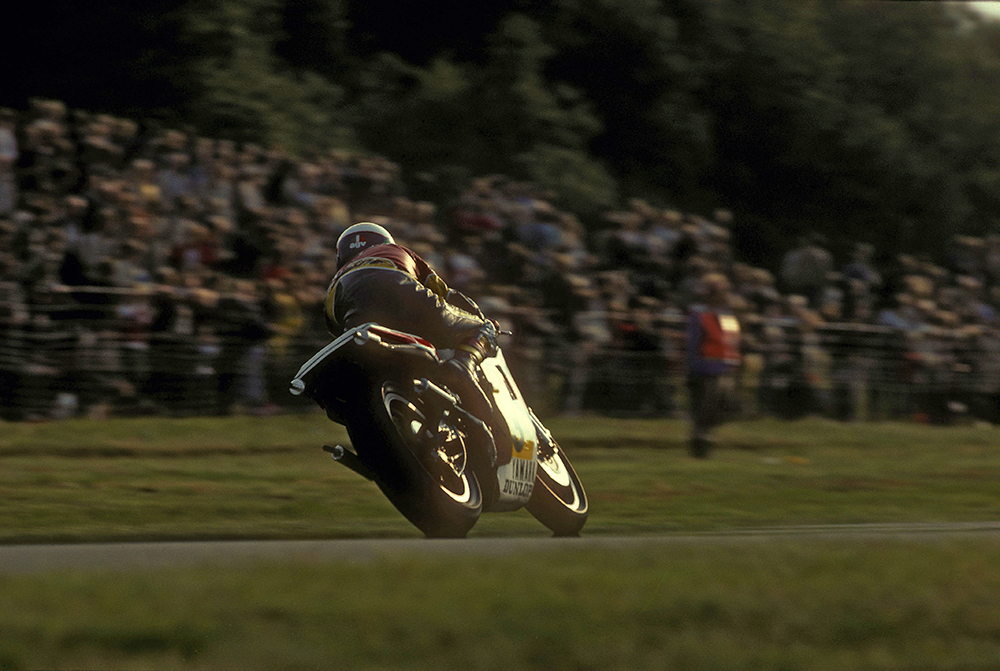
He may have stopped racing but the sun never really set on Kenny’s career
Season 1982 ended with more questions asked than could be answered. What if Yamaha had stuck with the 0W60 for another year? How much longer would Roberts want to race? Could he beat Spencer in 1983?
The answers lie in another story but one hint of how things unfolded is the fact that from 1983 until 1994 the only non-American to win the 500cc title was Australian Wayne Gardner in 1987. In those 10 seasons Yamaha won the championship six times.
And Roberts won both the 1983 and 1984 Daytona 200 on a bored and stroked 695cc version of the 0W60, called the 0W69. If only Yamaha had stuck with this configuration for its 500cc world championship attempt in 1982, another chapter could have been written in its rich history.

Roberts, Dutch 500GP, 1982
Words Hamish Cooper Photography Gold&Goose